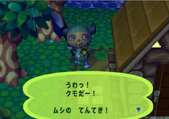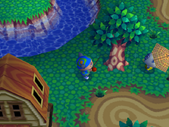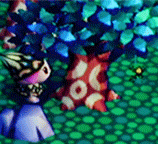(Update categories/change text to "bug" instead of "insect") |
No edit summary |
||
| Line 38: | Line 38: | ||
In {{NL}} they can be shaken out of fruit trees, even if fruit is still on the tree. |
In {{NL}} they can be shaken out of fruit trees, even if fruit is still on the tree. |
||
| − | They can be found during rain, and is the summer counterpart of the [[Bagworm]]. |
+ | They can be found during rain, and is the summer counterpart of the [[Bagworm]], which appears in winter. |
==Donating to the Museum== |
==Donating to the Museum== |
||
Revision as of 19:20, 17 April 2014
- "Whoa! I caught a spider! I bet some fly is gonna rest easy tonight!" —Animal Crossing
- "うわっ! クモだ-! ムシの てんてき!" —Animal Forest e+
- " (Translation) Crikey! It's a spider! It's the natural enemy of insects!" —Animal Forest e+
- "I caught a spider! You're in MY web now!" —Wild World
- "I caught a spider! Look at all those eyes!" —City Folk
- "I caught a spider! My net is kinda like a web, right?" —New Leaf
- "All right! The rare spider is mine all mine!" —Animal Crossing Movie
Template:SpNumber
The Spider can be found dangling from trees once they have been shaken by the player. They are fairly uncommon, but easy to catch, since they don't try to escape from the player if you approach them. If the tree is shaken when a spider is hanging out it will simply sway from side to side. If left too long it will retreat back into the tree where it either can be reshaken out (such as in Animal Crossing and its counterparts) or will simply disappear. When a spider is not hanging out of a tree, Villagers will look up at the tree if they happen to pass by, thus giving away the location of the spider. It is not to be confused with its ground-dwelling counterpart, the Tarantula.
In New Leaf they can be shaken out of fruit trees, even if fruit is still on the tree.
They can be found during rain, and is the summer counterpart of the Bagworm, which appears in winter.
Donating to the Museum
As with all bugs in the Animal Crossing series, the spider can be donated to the Museum followed by a small talk by Blathers, the curator.
In Animal Crossing
In Wild World
In Wild World, Blathers will say the following upon donation of a spider:
"I can think of nothing more repugnant than becoming entangled in a spider's web. After thrashing about, you think you got it all off, but no, indeed! A little tickle on your neck and you thrash anew! Blech! Such foulness..."
After donation, the spider can be found hanging in second-left bottom tree that shared with Rainbow Stag Beetle, hide in tree and only the legs that can seen. If Player near it, the spider will appear for few second, then hiding again.
In City Folk

A spider in the museum in City Folk.
Blathers, the curator of the museum, will accept the spider for donation to the bug exhibit.
After the player donates the spider in City Folk, he will give you some information:
"Horrors! My apologies, but I get rather jumpy around fast, multi-legged critters like this one, eh wot? Even worse is the fact that spiders have eight eyes! Even when it looks away, it can see our every move! I've heard some people worship the spider... And I've also heard that you will not find me in those places."
In New Leaf
In New Leaf an information board in the bug exhibit will list information about this bug.
"Spiders emit silk from their spinnerets and use it to create elaborate webs to snag prey. The horizontal threads are sticky to the touch, allowing them to be used as very strong restraints. However, the vertical threads are smooth, allowing spiders to walk on them without getting stuck."
After donating, the spider can be found on a tree in the central terrace of the bug exhibit. It will come down out of the tree on a thread when approached.
Encyclopedia Information
When the player has caught the spider, they can find information about it in the bug menu. Below is the information regarding the spider from the following Animal Crossing Games:
Animal Crossing
Template:BugEncycGCN
Wild World
Bug
|
Encyclopedia Information
| |

|
"They have eight legs. Their heads and chests are connected. Baby spiders can spin thread to fly." | |
| Size | 28 mm | |
| Time | All Day | |
| Season | Spring and summer. | |
| Icon | ||
City Folk
Bug
|
Encyclopedia Information
| ||||||||
| File:Spider |
| ||||||||
'New Leaf
Gallery
In Dōbutsu no Mori

The Spider's first appearance.
A spider appears in the Animal Forest movie, where at one point, Ai walks into one close to her home, causing her to freak out. Uncertain what it is, she picks it up, but once she realizes it is a spider, she swats if off her hand onto to floor.

The spider fleeing once being swatted off Ai's hand.
Yu then appears from the tree, catches it, glad that he beat Alfonso to the chase. In return, he offers Ai a cockroach, which worsens the situation as it flies onto Ai's face. Yu claims the spider to be rare, but it is actually quite common.
Further Information
Argiope bruennichi, commonly known as the wasp spider, is a common species of spider that can be found in Europe, Africa and areas of Asia. They are extremely agressive towards others of the species.






